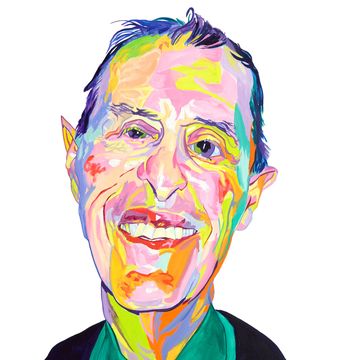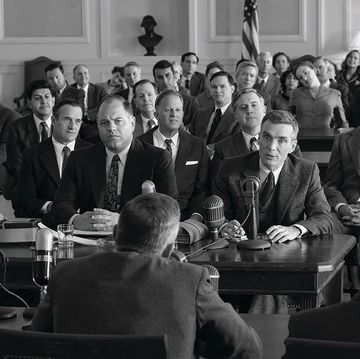Standing in front of a classroom chalkboard at UC Berkeley, Professor J. Robert Oppenheimer begins his very first course. The lone student in quantum mechanics takes notes. In the montage that follows in Christopher Nolan’s Oppenheimer, the class size grows along with the physicist’s reputation. But it’s the moment in that first lecture when Oppenheimer—portrayed by Cillian Murphy—describes the paradoxes of waves and particles (a glimmer in his pale blue eyes) that epitomizes the complexity the director has delivered with his adaptation of Martin J. Sherwin and Kai Bird’s 2005 American Prometheus: The Triumph and Tragedy of J. Robert Oppenheimer.
Forget the nod to the Greeks implied in the biography’s title. The hubris and betrayals, the desire and guilt, the hints of doubt and undercurrent of demise roiling Nolan’s masterful distillation of the 700-page, Pulitzer Prize–winning tome make the story of the race to build the world’s first nuclear weapon utterly Shakespearean. Yet the palaces of intrigue—situated in the Bay Area; in Princeton, New Jersey; in Washington, D.C.; and most famously in the high desert of Los Alamos, New Mexico—render it profoundly American.
Looking gaunt and haunted, Murphy’s Oppenheimer has little of the remarked-upon charisma, but many of the dark moods, of the scientist christened the father of the atomic bomb. And this film about the gift and curse of fire cheekily begins with water. A student at Cambridge University, Oppenheimer appears lost in thought as he stares at puddles and the concentric circles stirred by raindrops. The film quickly makes clear that Oppenheimer is bedeviled by flashes of images, glimpses of not-yet-moored insights. And Nolan splices visuals of sparks and arcs of blue-white energy to capture the young physicist’s inner state.
Exemplifying fusion and fission, Oppenheimer wrangles the teamwork that made the dream (nightmare) work. Matt Damon plays the gruff Army Corps of Engineers officer who drafts Oppenheimer for the undertaking. The three-hour film rides on the urgency of the Manhattan Project’s mission of delivering the first atomic bomb (Germany, too, has a team of physicists working on an A-bomb) even as its leaders navigate the brewing Cold War paranoia that leads to Oppenheimer’s heartbreak.
The biopic doggedly traces the relationships, friendships, and acquaintanceships in Berkeley that made Oppenheimer a target of red-scare tactics. Nolan efficiently depicts the Bay Area’s mix of card-carrying members of the Communist Party of the United States, fellow travelers, and citizens simply engaged in causes that made them suspect, among them racial equality, labor rights, and the support of the Republican fighters in the Spanish Civil War.
Robert Downey Jr. teases the canny and then unhinged energy of Lewis Strauss, the man who brings Oppenheimer to the Institute for Advanced Study, in Princeton, and then aches for his downfall. A brief exchange between Oppenheimer; the institute’s most famous faculty member, Albert Einstein; and Strauss, who headed the Atomic Energy Commission, sows the first seed of the latter’s resentment. There will be more.
Sons of Jewish immigrants, Strauss and Oppenheimer couldn’t be more different. Strauss is certain he can control the political narrative. Oppenheimer is shaken by the questioning of his fealty. Each will endure a hearing that unfolds like an inquisition: Oppenheimer’s security-clearance questioning in 1954 and Strauss’s confirmation hearing in 1959.
Nolan and his go-to cinematographer, Hoyte Van Hoytema, use black-and-white footage to delineate the period in which Strauss is being vetted for secretary of commerce in the Eisenhower administration. It’s a trenchant decision to shoot that hearing and the machinations leading up to it in black-and-white, underscoring the stark us/them ideology of the era. Editor Jennifer Lame keeps the leaps in time cogent and compelling as the movie interweaves the scenes at Los Alamos with those of Strauss’s hearing and the kangaroo court assembled to decide whether one of the nation’s loyal scientist-servants retains his security clearance.
Sitting in a narrow office crammed with interrogators and one outmatched defense attorney, Oppenheimer answers questions in a near whisper. Thank goodness for Emily Blunt’s performance as Kitty Oppenheimer, who models what backbone looks like for her seemingly defeated husband. Kitty going head-to-head with special counsel Roger Robb (Jason Clarke) is archly written and deeply satisfying. If Oppenheimer has a secret weapon, it’s Blunt.
In addition to Downey and Blunt, Nolan has harnessed his own ace team. Florence Pugh portrays Oppenheimer’s lover Jean Tatlock, who is training to be a psychiatrist. Casey Affleck makes an unblinking turn as the quiet counterintelligence zealot Boris Pash. As famed physicist Niels Bohr, Kenneth Branagh appears early in a scene at Cambridge that gets laughs (but perhaps shouldn’t) and again later at Los Alamos, when he nails the gravity of Oppenheimer’s undertaking.
Regrets? Oppenheimer has a few. Some are personal: his relationship with Tatlock proves untenable and indelible. Others mark him as a progenitor of what we now call moral injury. When Oppenheimer’s conscience leads him to speak out against what he sees as the dawning of an unwinnable arms race, he is accused of being a Communist and also, in the immortal words of Harry S. Truman (Gary Oldman), a “crybaby.”
Oppenheimer is epic—available in IMAX and ideal for theater screens—yet perhaps smaller than it should be. A filmmaker rightly celebrated for his cinematic savvy, Nolan has chosen to not use the might of cinema—its persuasive, increasingly jaw-dropping visual tricks—to show the horrors inflicted on Hiroshima and Nagasaki, on August 6 and August 9, 1945, respectively. Much like the movie’s embrace of paradox, it’s a decision to be respected but also questioned.
In a dodge that Tatlock, the shrink in training, might have appreciated, the vulnerability of human bodies has been displaced onto lovers Oppenheimer and Tatlock. Instead of wrestling with the physical devastation wrought by the bombs named Little Boy and Fat Man, Tatlock insists that Oppenheimer read aloud from his Sanskrit copy of the Bhagavad Gita as she mounts him and they begin having sex. Asked about his thoughts at the moment of the successful detonation of the bomb in New Mexico, Oppenheimer answered with the same line of Hindu scripture: “Now I am become Death, the destroyer of worlds.”
If the film has—to look to the Greeks at last—an Achilles’ heel, it is that so capable a director as Nolan did not figure out a way to truly acknowledge the human toll of Oppenheimer and the Manhattan Project’s creation. While there are a great many of us for whom the newsreel images of the devastation remain unshakably vivid, there are fresh generations who know only moviedom’s increasingly promiscuous fantasizing about the obliteration not of worlds but of multiverses.
In a scene that says much about Oppenheimer’s sense of guilt but also perhaps his lack of moral courage, the physicist turns his head downward and closes his eyes when footage (that we do not see) of Hiroshima plays. That he averts his gaze says a lot about the film’s complex if tarnished protagonist. But what does Nolan’s averting of our gaze say about us?•
Lisa Kennedy writes about film, theater, and culture. She lives in Denver, teaches nonfiction writing, and is at work on Icarus Ascending, a memoir set during the early years of the AIDS crisis. Since returning to the West after years on the East Coast, she has often looked to Joan Didion to grapple with writing about place.











